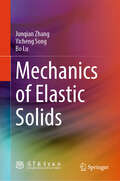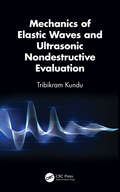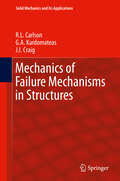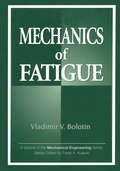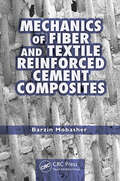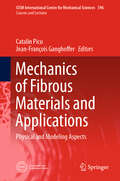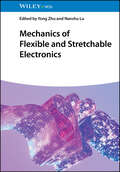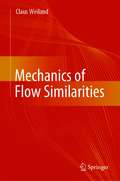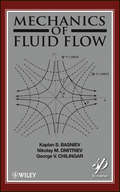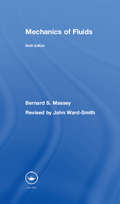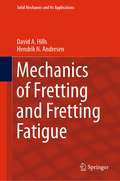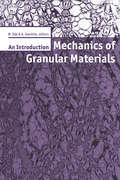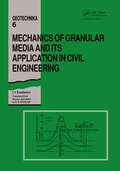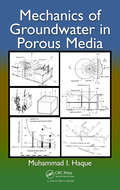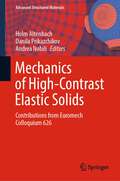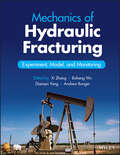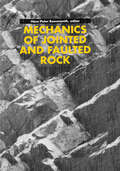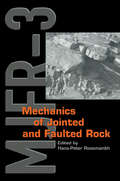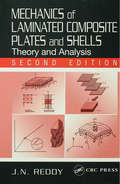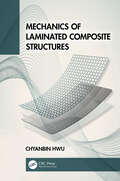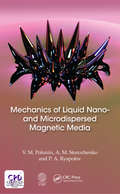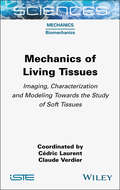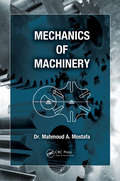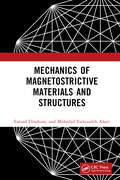- Table View
- List View
Mechanics of Elastic Solids
by Bo Lu Junqian Zhang Yicheng SongThis book entitled Mechanics of Elastic Solids is written as a textbook of the course “Elasticity” or “Theory of Elasticity” or “Elasticity Mechanics” for relevant engineering majors. It can also be used as a professional book for relevant technical persons. It mainly introduces elasticity theory, including stress analysis, deformation analysis, constitutive relations, elasticity model construction for actual problems, solutions for infinitesimal plane stress and strain problems, three-dimensional problems, multiphysics field problems, variation principle in elasticity, thin plate, and cylindrical shells. The rapid and continuous advancements in numerical methods and computer power have diminished the significance of certain analytical solutions in elasticity problems.. Therefore, this book simplifies some traditional contents such as the solution of plane problems and twist of cylinder. Instead, some new topics which are important for real-world problems are introduced, such as the accurate description of finite deformation, constitutive equations for small strain but large rotation problems, hyperelasticity, procedural steps and general methodologies for model construction of real-world problems, and multiphysics field problems. A plenty of examples is prepared in this book for comprehensive understanding.
Mechanics of Elastic Waves and Ultrasonic Nondestructive Evaluation
by Tribikram KunduSummary:This book presents necessary background knowledge on mechanics to understand and analyze elastic wave propagation in solids and fluids. This knowledge is necessary for elastic wave propagation modeling and for interpreting experimental data generated during ultrasonic nondestructive testing and evaluation (NDT&E). The book covers both linear and nonlinear analyses of ultrasonic NDT&E techniques. The materials presented here also include some exercise problems and solution manual. Therefore, this book can serve as a textbook or reference book for a graduate level course on elastic waves and/or ultrasonic nondestructive evaluation. It will be also useful for instructors who are interested in designing short courses on elastic wave propagation in solids or NDT&E. <P><P>The materials covered in the first two chapters provide the fundamental knowledge on linear mechanics of deformable solids while Chapter 4 covers nonlinear mechanics. Thus, both linear and nonlinear ultrasonic techniques are covered here. Nonlinear ultrasonic techniques are becoming more popular in recent years for detecting very small defects and damages. However, this topic is hardly covered in currently available textbooks. Researchers mostly rely on published research papers and research monographs to learn about nonlinear ultrasonic techniques. Chapter 3 describes elastic wave propagation modeling techniques using DPSM. Chapter 5 is dedicated to an important and very active research field – acoustic source localization – that is essential for structural health monitoring and for localizing crack and other type of damage initiation regions. <P><P>Features <li> Introduces Linear and Nonlinear ultrasonic techniques in a single book. <li>Commences with basic definitions of displacement, displacement gradient, traction and stress. <li> Provides step by step derivations of fundamental equations of mechanics as well as linear and nonlinear wave propagation analysis. <li> Discusses basic theory in addition to providing detailed NDE applications.• <li>Provides extensive example and exercise problems along with an extensive solutions manual.
Mechanics of Failure Mechanisms in Structures
by J. I. Craig G. A. Kardomateas R. L. CarlsonThis book focuses on the mechanisms and underlying mechanics of failure in various classes of materials such as metallic, ceramic, polymeric, composite and bio-material. Topics include tensile and compressive fracture, crack initiation and growth, fatigue and creep rupture in metallic materials, matrix cracking and delamination and environmental degradation in polymeric composites, failure of bio-materials such as prosthetic heart valves and prosthetic hip joints, failure of ceramics and ceramic matrix composites, failure of metallic matrix composites, static and dynamic buckling failure, dynamic excitations and creep buckling failure in structural systems. Chapters are devoted to failure mechanisms that are characteristic of each of the materials. The work also provides the basic elements of fracture mechanics and studies in detail several niche topics such as the effects of toughness gradients, variable amplitude loading effects in fatigue, small fatigue cracks, and creep induced brittleness. Furthermore, the book reviews a large number of experimental results on these failure mechanisms. The book will benefit structural and materials engineers and researchers seeking a "birds-eye" view of possible failure mechanisms in structures along with the associated failure and structural mechanics.
Mechanics of Fatigue (Mechanical and Aerospace Engineering Series #11)
by Vladimir V. BolotinMechanics of Fatigue addresses the range of topics concerning damage, fatigue, and fracture of engineering materials and structures. The core of this resource builds upon the synthesis of micro- and macro-mechanics of fracture. In micromechanics, both the modeling of mechanical phenomena on the level of material structure and the continuous approach are based on the use of certain internal field parameters characterizing the dispersed micro-damage. This is referred to as continuum damage mechanics.The author develops his own theory for macromechanics, called analytical fracture mechanics. This term means the system cracked body - loading or loading device - is considered as a mechanical system and the tools of analytical (rational) mechanics are applied thoroughly to describe crack propagation until the final failure.Chapter discuss:preliminary information on fatigue and engineering methods for design of machines and structures against failures caused by fatiguefatigue crack nucleation, including microstructural and continuous modelstheory of fatigue crack propagationfatigue crack growth in linear elastic materials subject to dispersed damagefatigue cracks in elasto-plastic material, including crack growth retardation due to overloading as well as quasistationary approximationfatigue and related phenomena in hereditary solidsapplication of the theory fatigue crack growth considering environmental factorsunidirectional fiber composites with ductile matrix and brittle, initially continuous fiberslaminate compositesMechanics of Fatigue serves students dealing with mechanical aspects of fatigue, conducting research in fracture mechanics, structural safety, mechanics of composites, as well as modern branches of mechanics of solids and structures.
Mechanics of Fiber and Textile Reinforced Cement Composites
by Barzin MobasherAmong all building materials, concrete is the most commonly used-and there is a staggering demand for it. However, as we strive to build taller structures with improved seismic resistance or durable pavement with an indefinite service life, we require materials with better performance than the conventional materials used today. Considering the enor
Mechanics of Fibrous Materials and Applications: Physical and Modeling Aspects (CISM International Centre for Mechanical Sciences #596)
by Jean-François Ganghoffer Catalin PicuThe book explores the state of the art in the mechanics of fibrous media, providing an overview of the theoretical, modelling and practical aspects of designing and working with these materials. It also describes the advanced methods needed to handle their specific features, including the mechanics of generalized continua, dedicated homogenization methods and computational techniques, and presents applications of fibrous media to diverse fields and over a broad spectrum of scales, ranging from aeronautics to biomechanics.
Mechanics of Flexible and Stretchable Electronics
by Yong Zhu Nanshu LuDiscover a comprehensive overview and advances in mechanics to design the cutting edge electronics Soft electronics systems, which include flexible and stretchable electronics, are an area of technology with the potential to revolutionize fields from healthcare to defense. Engineering for flexibility and stretchability without compromising electronic functions poses serious challenges, and extensive mechanics and engineering knowledge is required to meet these challenges. Mechanics of Flexible and Stretchable Electronics introduces a range of soft functional materials and soft structures and their potential applications in the construction of soft electronics systems. Its detailed attention to the mechanics of these materials and structures makes it an indispensable tool for scientists and engineers at the cutting edge of electronics technology. Mechanics of Flexible and Stretchable Electronics readers will also find: A detailed summary of recent advances in the field Detailed treatment of structures including kirigami, serpentine, wrinkles, and many more A multidisciplinary approach suited to a varied readership Mechanics of Flexible and Stretchable Electronics is ideal for electronics and mechanical engineers, solid state physicists, and materials scientists, as well as the libraries that support them.
Mechanics of Flow Similarities
by Claus WeilandThe mechanics of similarity encompasses the analysis of dimensions, performed by various procedures, the gasdynamic similarity and the model technology. The analysis of dimensions delivers the dimensionless numbers by which specific physical challenges can be described with a reduced number of variables. Thereby the assessment of physical problems is facilitated. For fluid dynamics and all sorts of heat transfer the discipline of the mechanics of similarity was so important in the past, that the historical background is highlighted of all the persons who have contributed to the development of this discipline. The goal of the classical gasdynamic similarity was to find rules, which enables the aerodynamic engineer to perform transformations from existing flow fields to others, which meet geometrical and other specific flow field parameters. Most of these rules and findings do no longer play a role today, because a lot of potent experimental and theoretical/numerical methods are now available. This problem is addressed in the book. A recent investigation regarding the longitudinal aerodynamics of space vehicles has revealed, that there exist other astonishing similarities for hypersonic and supersonic flight Mach numbers. It seems, that obviously most of the longitudinal aerodynamics is independent from the geometrical configurations of the space vehicle considered, if a simple transformation is applied. A section of this book is devoted to these new findings.
Mechanics of Fluid Flow
by George V. Chilingar Misha Gorfunkle Amir G. Mohammed Nejad Nikolay M. Dmitriev Kaplan S. BasnievThe mechanics of fluid flow is a fundamental engineering discipline explaining both natural phenomena and human-induced processes, and a thorough understanding of it is central to the operations of the oil and gas industry. This book, written by some of the world's best-known and respected petroleum engineers, covers the concepts, theories, and applications of the mechanics of fluid flow for the veteran engineer working in the field and the student, alike. It is a must-have for any engineer working in the oil and gas industry.
Mechanics of Fluids
by John Ward-SmithAs in previous editions, this ninth edition of Massey’s Mechanics of Fluids introduces the basic principles of fluid mechanics in a detailed and clear manner. This bestselling textbook provides the sound physical understanding of fluid flow that is essential for an honours degree course in civil or mechanical engineering as well as courses in aeronautical and chemical engineering. Focusing on the engineering applications of fluid flow, rather than mathematical techniques, students are gradually introduced to the subject, with the text moving from the simple to the complex, and from the familiar to the unfamiliar. In an all-new chapter, the ninth edition closely examines the modern context of fluid mechanics, where climate change, new forms of energy generation, and fresh water conservation are pressing issues. SI units are used throughout and there are many worked examples. Though the book is essentially self-contained, where appropriate, references are given to more detailed or advanced accounts of particular topics providing a strong basis for further study. For lecturers, an accompanying solutions manual is available.
Mechanics of Fretting and Fretting Fatigue (Solid Mechanics and Its Applications #266)
by David A. Hills Hendrik N. AndresenThis book, which has only one very distant forerunner authored by David A. Hills with David Nowell, represents a very big step that is the quantification of these problems and represents the twenty-five years’ worth of work which have gone on at Oxford since the first book on the subject. Fatigue (popularly ‘metal fatigue’) is the primary failure mode of all machines, engines, transmissions and indeed almost all mechanical devices. The propagation of cracks is well understood and is treated in the subject Fracture Mechanics. By contrast, the nucleation of cracks is very hard to quantify and this remains the case with so-called ‘free initiation’ and, to a lesser extent, at cracks nucleated from stress raising features. But the third form of nucleation, where cracks start from the edges of rubbing components, that is, at joints, is potentially a very much better-defined environment, and therefore, the problem is amendable to attack by applied mechanics and experiment. The contents are of value both to those embarking on research on the subject and to practitioner in industry.
Mechanics of Granular Materials: An Introduction
by K. Iwashita M. OdaThis textbook compiles reports written by about 35 internationally recognized authorities, and covers a range of interests for geotechnical engineers. Topics include: fundamentals for mechanics of granular materials; continuum theory of granular materials; and discrete element approaches.
Mechanics of Granular Media and Its Application in Civil Enginenering: Geotechnika - Selected Translations of Russian Geotechnical Literature 6
by I.I. KandaurovSystematic approach to the construction of a probabilistic simulation model for distribution of pressure in granular media. Pressure fields & compressive deformations from that model presented for a thrustless granular medium & homogeneous or stratified earth foundation. General solutions incorporating partial cases of thrustless & thrusting granular media.
Mechanics of Groundwater in Porous Media
by Muhammad I. HaqueProvides a Balance between the Mathematical and Physical Aspects and the Engineering ApplicationsWritten for engineering and science students, Mechanics of Groundwater in Porous Media explains groundwater from both a mathematical and qualitative standpoint. The book builds up the theory of groundwater flow starting from basic physics and geometric
Mechanics of Heterogeneous Materials (Advanced Structured Materials #195)
by Wolfgang H. Müller Holm Altenbach Victor A. Eremeyev Giovanni Bruno Mikhail Yu. GutkinThis book is published on dedication of Prof. Dr. Igor Sevostianov who passed away in 2021. He was a great Russian-American scientist who made significant contributions in the field of mechanics of heterogeneous media. This book contains research papers from his friends and colleagues in this research field.
Mechanics of High-Contrast Elastic Solids: Contributions from Euromech Colloquium 626 (Advanced Structured Materials #187)
by Holm Altenbach Danila Prikazchikov Andrea NobiliThis book contains the most recent results in the area of strongly inhomogeneous composite structures, including layered materials as well as continua with microstructure. This collection of papers mainly arises from the Euromech Colloquium No. 626 on “Mechanics of High-Contrast Elastic Composites”. Focus is set on the peculiar mechanical behaviour caused by adjoining widely different structural elements (high contrast) in terms of material and/or geometrical properties.
Mechanics of Hydraulic Fracturing: Experiment, Model, and Monitoring
by Xi Zhang Bisheng Wu Diansen Yang Andrew BungerMechanics of Hydraulic Fracturing Comprehensive single-volume reference work providing an overview of experimental results and predictive methods for hydraulic fracture growth in rocks Mechanics of Hydraulic Fracturing: Experiment, Model, and Monitoring provides a summary of the research in mechanics of hydraulic fractures during the past two decades, plus new research trends to look for in the future. The book covers the contributions from theory, modeling, and experimentation, including the application of models to reservoir stimulation, mining preconditioning, and the formation of geological structures. The four expert editors emphasize the variety of diverse methods and tools in hydraulic fracturing and help the reader understand hydraulic fracture mechanics in complex geological situations. To aid in reader comprehension, practical examples of new approaches and methods are presented throughout the book. Key topics covered in the book include: Prediction of fracture shapes, sizes, and distributions in sedimentary basins, plus their importance in petroleum industry Real-time monitoring methods, such as micro-seismicity and trace tracking How to uncover geometries of fractures like dikes and veins Fracture growth of individual foundations and its applications Researchers and professionals working in the field of fluid-driven fracture growth will find immense value in this comprehensive reference on hydraulic fracturing mechanics.
Mechanics of Jointed and Faulted Rock
by Hans Peter RossmanithThis book focuses on the implementation and application of new concepts and methods to modelling, analysis, building, performance control and repair of structures of and in jointed rock and rock masses. It provides a forum for presentation of new research results and discussion for researchers.
Mechanics of Jointed and Faulted Rock
by Hans-Peter RossmanithTopics covered in this text include: geology and structural geology; mechanics; dynamics of jointed and faulted rock; physical modelling and testing; constitutive modelling; seismicity and tectonics; instrumentation; hydraulics; and applications.
Mechanics of Laminated Composite Plates and Shells: Theory and Analysis, Second Edition (Applied and Computational Mechanics)
by J. N. ReddyThe second edition of this popular text provides complete, detailed coverage of the various theories, analytical solutions, and finite element models of laminated composite plates and shells. The book reflects advances in materials modeling in general and composite materials and structures in particular. It includes a chapter dedicated to the theory and analysis of laminated shells, discussions on smart structures and functionally graded materials, exercises and examples, and chapters that were reorganized from the first edition to improve the clarity of the presentation.
Mechanics of Laminated Composite Structures
by Chyanbin HwuIn this textbook for students of laminated composite materials, composite structures, and anisotropic elasticity, Chyanbin Hwu draws on more than three decades of research and applications experience to provide a leading resource on many unique topics related to laminated composite structures.This book introduces the mechanical behavior of laminated composite materials and provides related theories and solutions. All basic structural elements such as beams, plates, and shells are described in detail. Further contents include composite sandwich construction and composite wing structures. To connect with practical engineering applications and analyze more complicated real structures, numerical methods and their theoretical basis in anisotropic elasticity are also included. Advanced topics addressed include solutions for magneto-electro-elastic laminated plates; Green’s functions for thick laminated plates and beams; typical thick laminated beams; theory for general laminated composite shells; sandwich beams, plates, and cylindrical shells as well as delaminated composite sandwich beams; modeling and analysis of composite wing structures; complex variable theories of anisotropic elasticity and the related Green’s functions; and numerical methods such as finite element method, boundary element method and meshless method. Through this book, readers will learn not only the mechanics of laminated composite structures but also anisotropic elasticity and some popular numerical methods.This textbook is vital for advanced undergraduate and graduate students interested in the mechanics of composite materials, composite structures, and anisotropic elasticity, such as aerospace, mechanical, civil, and naval engineering; applied mechanics; and engineering science. It is also useful for engineers working in these fields and applied mathematicians and material scientists.
Mechanics of Liquid Nano- and Microdispersed Magnetic Media
by V. M. Polunin A. M. Storozhenko P.A. RyapolovThis book offers unique coverage of the mechanical properties of nano- and micro-dispersed magnetic fluids. Magnetic fluids are artificially created materials that do not exist in the nature. Researchers developing materials and devices are keenly interested in their "mutually exclusive" properties including fluidity, compressibility, and the ability to magnetize up to saturation in relatively small magnetic fields. Applications of micro- and nanodispersed magnetic fluids include magnetic-seals, magnetically operated grease in friction units and supports, separators of non-magnetic materials, oil skimmers and separators, sensors of acceleration and angle, and gap fillers in loudspeakers.
Mechanics of Living Tissues: Imaging, Characterization and Modeling Towards the Study of Soft Tissues (ISTE Invoiced)
by Claude Verdier C Dric LaurentDespite their many common features (mechanical behavior, multi-scale structure, evolutionary and living characteristics, etc.), the tissues that make up the human body each have specific characteristics linked to their function, which require the development of dedicated experimental, theoretical and numerical methods. Mechanics of Living Tissues brings together the work of a number of experts to provide an overview of the most recent approaches developed to study the biomechanical behavior of these soft tissues, in order to understand their structure and apparent behavior. Specific tissues are analyzed across the chapters with the aim of developing solutions that address the clinical problems encountered. Conclusions are then drawn regarding future methods that will improve the current state of knowledge of the behavior of these living tissues, in particular with a view to predicting the effect of a pathology or medical procedure on their apparent properties.
Mechanics of Machinery
by Mahmoud A. MostafaMechanics of Machinery describes the analysis of machines, covering both the graphical and analytical methods for examining the kinematics and dynamics of mechanisms with low and high pairs. This text, developed and updated from a version published in 1973, includes analytical analysis for all topics discussed, allowing for the use of math software
Mechanics of Magnetostrictive Materials and Structures
by Farzad Ebrahimi Mehrdad Farajzadeh AhariMechanics of Magnetostrictive Materials and Structures demonstrates the practical applications and uses for cutting-edge smart magnetostrictive materials. Exploring the analytical and numerical solution procedures and characteristics of these materials more generally, the book details how these materials respond to external factors. Exceptionally adjustable and adaptable, magnetostrictive materials are artifcial structures that offer distinctive physical properties. Providing clear illustrations throughout, this book includes a comprehensive guide to the theory and its applications. Presenting the mathematical tools needed to analyze magnetostrictive materials and structures, through the use of MATLAB®, the book will also detail static analysis. Comprehensively assessing the practicalities of these smart materials, it also discusses vibration and buckling under different loads, alongside dynamic behavior. Features: Includes MATLAB® for analytical and numerical simulations relevant to mechanics of magnetostrictive materials Presents vibration analysis of magnetostrictive materials and structures Demonstrates and analyzes the effect of implementing boundary conditions on the mechanical responses of magnetostrictive structures Examines the use of smart materials in engineering structures Aimed at students and professionals working in the field of mechanics, materials and dynamics, the book is an essential guide to this rapidly developing area.
